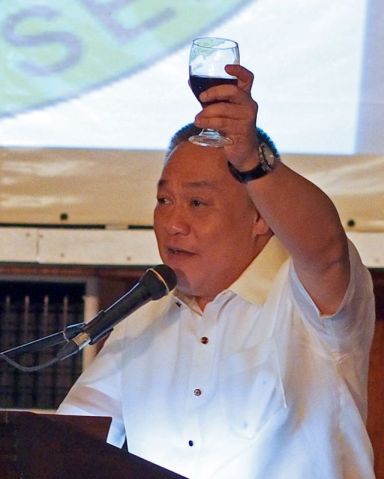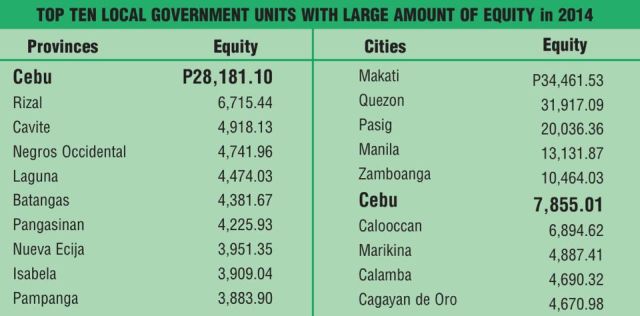COA report: Cebu local gov’t has the most assets, equity among 80 provinces
Cebu city is no. 6 among cities
Cebu still has the wealthiest provincial government in the Philippines, according to state auditors.
Cebu ranks first among 80 provinces in the country as having the largest assets and equity based on the 2014 Annual Financial Report of the Commission on Audit (COA).
The financial trend has been consistent for several years.
Assets alone of Cebu province reach P29.6 billion, according to the COA report which reviewed the financial position, cash and performance of local governments nationwide for 2014.

Cebu Gov. Hilario Davide III leads a toast at a gala dinner in August 8, 2014 for the founding anniversary of Cebu province. That’s the year the Commision on Audit financial report said Cebu province registered the highest value of assets and equity in the country, besting its own past record.
According to Capitol officials, most of Cebu province’s assets are in real estate of about 1,000 parcels of land. Several are located in Cebu city where property values are high.
In the category of cities, Makati got the top spot with P34.4 billion in equity, exceeding the wealthiest of provinces. Equity is determined by computing the value of assets less liabilities.
The auditor’s report, however, does not say how much of the prosperity has reached Cebu province’s 4 billion population, a trickle down effect which economists call “inclusive growth”.
In a COA list of top ten provinces based on equity, Cebu province ranked highest with P28.18 billion.
“Wow! That is such good news,” said Cebu Gov. Hilario Davide III after receiving a copy of the 270-page COA annual report dated Sept. 16 submitted to President Benigno Aquino III.
Cebu was way ahead of the provinces of Rizal (P6.7 billion), Cavite (P4.9 billion), Negros Occidental (P4.7 billion), and Laguna (P4.47 billion), in equity (See table of top 10 provinces.)
Davide said the good financial performance could be one reason Cebu was named third most competitive province in the recent National Competitiveness Council rankings and received a seal of good local governance from the Department of Interior and Local Government (DILG).
“One of the criteria of the award is financial capability. I am just so happy,” said Davide.
He credited the no. 1 standing to the contributions of a “very proactive private sector”, new investments and the efforts of all government personnel.
CONTINUING TREND
The financial standing is actually not new.
Cebu also topped the list of provinces in previous years, a source of pride for former governor Gwendolyn Garcia.

Source: Commission on Audit 2014 Annual Financial Report.
During her last term in 2010, she had bragging rights when the Cebu provincial government was declared the richest in the country when it posted assets of P16.1 billion for the year before.
In 2006, still during her term, COA reported that Cebu province was no. 1 with P10.8 billion in equity, the highest among 77 provinces at the time.
With the May elections approaching, and political attacks among candidates stepping up, Cebu province’s premier status has been a central issue.
Garcia, a 3rd district congresswoman, is seeking reelection while younger brother Winston is challenging Davide’s reelection. Both paint the governor as a non-performer who has diminished Cebu province’s “no. 1” stature.
Asked whether the recent COA findings negate his detractors, Davide said he has accepted that criticism will continue.
“Whatever we say we achieved or did for the province, they will not stop. But let them be. They’re used to that. That’s where their happiness is. They want to destroy me and everyone around me,” said Davide.
Gwen Garcia, in a text message, said “it is a pity that such ‘richness’ has not been translated into much-needed infrastructure projects, health and social services for our barangays and towns suffering from an undeserved ‘El Niño’ of such provincial government assistance.”
“Instead, all these funds have been hoarded by this present administration, in the erroneous belief that government is a savings bank,” said Garcia.
In 2007, when COA reported that Cebu province has the highest equity, assets and cash in bank, Garcia at the time made a similar comment about the need to use the province’s wealth for development.
“In spite of having spent much, there is still so much to spend,” she said at the time.
RICH CITIES
COA said Cebu province’s financial position showed current assets for 2014 amounting to P2.3 billion. Its non-current assets total P27.36 billion.
Liabilities were recorded at around P1.5 billion.
Emmanuel Guial, Cebu provincial treasurer, said the figures show the province is “rich” and financially “solvent”.
He said its liquid assets like cash on hand and investments can be quickly converted into cash.
Solvency, said Guial, is a gauge of how a local government unit is able to meet its short-term and long-term financial obligations.
In terms of financial performance, the COA report said Cebu province had P2.76 billion in income, and P2.11 billion in expenses resulting in P651.7 million in net income in 2014.
For its cash position, Cebu province had a beginning cash balance of P1.13 billion and ending cash balance of P1.75 billion.
For 2014, the Capitol’s general fund was recorded at P1.178 billion and about P174 million in the Special Education Fund (SEF) as cash on hand.
Earlier this year, the Davide administration said it plans to develop six province-owned lots and dispose of two in order to maximize its assets.
Lots in the Maria Luisa Subdivision in Busay, Cebu City were identified for disposal.
Part of the lot of the Cebu South Bus Terminal near Fuente Osmena will be commercially developed.
Disclaimer: The comments uploaded on this site do not necessarily represent or reflect the views of management and owner of Cebudailynews. We reserve the right to exclude comments that we deem to be inconsistent with our editorial standards.
